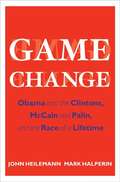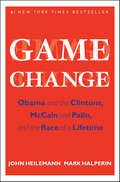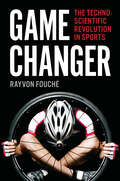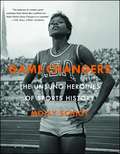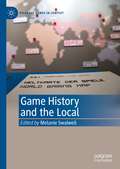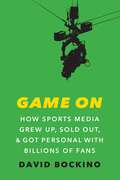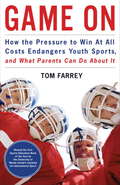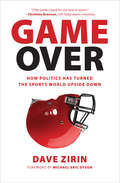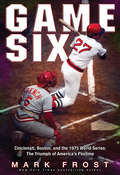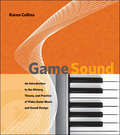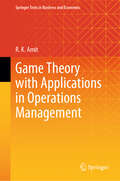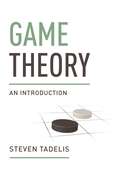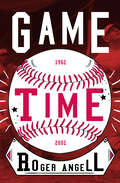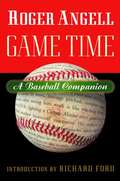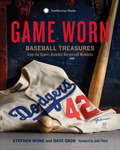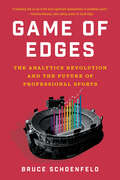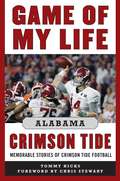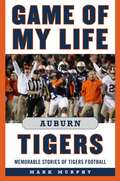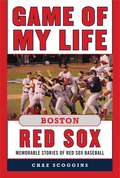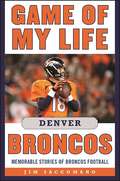- Table View
- List View
Gamboa's World: Justice, Silver Mining, and Imperial Reform in New Spain (Diálogos Series)
by Christopher AlbiGamboa&’s World examines the changing legal landscape of eighteenth-century Mexico through the lens of the jurist Francisco Xavier de Gamboa (1717–1794). Gamboa was both a representative of legal professionals in the Spanish world and a central protagonist in major legal controversies in Mexico. Of Basque descent, Gamboa rose from an impoverished childhood in Guadalajara to the top of the judicial hierarchy in New Spain. He practiced law in Mexico City in the 1740s, represented Mexican merchants in Madrid in the late 1750s, published an authoritative commentary on mining law in 1761, and served for three decades as an Audiencia magistrate. In 1788 he became the first locally born regent, or chief justice, of the High Court of New Spain. In this important work, Christopher Albi shows how Gamboa&’s forgotten career path illuminates the evolution of colonial legal culture and how his arguments about law and justice remain relevant today as Mexico debates how to strengthen the rule of law.
Game 7, 1986: Failure and Triumph in the Biggest Game of My Life
by Daniel Paisner Ron DarlingNew York Times Bestseller: Mets starting pitcher Ron Darling reflects on his role in the dramatic World Series tiebreaker in this candid personal memoir.Every little kid who’s ever taken the mound in Little League dreams of someday getting the ball for Game Seven of the World Series. Ron Darling got to live that dream—only it didn’t go exactly as planned. In Game 7, 1986, the award-winning baseball analyst looks back at what might have been a signature moment in his career, and reflects on the ways professional athletes must sometimes shoulder a personal disappointment as their teams find a way to win.Darling’s memoir breaks down one of baseball’s great “forgotten” games—a game that stands as a thrilling, telling, and tantalizing exclamation point to one of the best-remembered seasons in Major League Baseball history. Game 7, 1986 is a book for the thinking baseball fan, a chance to reflect on what it means to compete at the game’s highest level, with everything on the line.“A departure from the typical sports narrative.” —New York Daily News“What makes this book so interesting is how Darling puts the reader into his head as he stands on the mound in Game 7. ”—The Tampa Tribune
Game Change: Obama and the Clintons, McCain and Palin, and the Race of a Lifetime
by Mark Halperin John Heilemann"This shit would be really interesting if we weren't in the middle of it."--Barack Obama, September 2008. In 2008, the presidential election became blockbuster entertainment. Everyone was watching as the race for the White House unfolded like something from the realm of fiction. The meteoric rise and historic triumph of Barack Obama. The shocking fall of the House of Clinton--and the improbable resurrection of Hillary as Obama's partner and America's face to the world. The mercurial performance of John McCain and the mesmerizing emergence of Sarah Palin. But despite the wall-to-wall media coverage of this spellbinding drama, remarkably little of the real story behind the headlines has yet been told. In Game Change, John Heilemann and Mark Halperin, two of the country's leading political reporters, use their unrivaled access to pull back the curtain on the Obama, Clinton, McCain, and Palin campaigns. How did Obama convince himself that, despite the thinness of his résumé, he could somehow beat the odds to become the nation's first African American president? How did the tumultuous relationship between the Clintons shape--and warp--Hillary's supposedly unstoppable bid? What was behind her husband's furious outbursts and devastating political miscalculations? Why did McCain make the novice governor of Alaska his running mate? And was Palin merely painfully out of her depth--or troubled in more serious ways? Game Change answers those questions and more, laying bare the secret history of the 2008 campaign. Heilemann and Halperin take us inside the Obama machine, where staffers referred to the candidate as "Black Jesus." They unearth the quiet conspiracy in the U.S. Senate to prod Obama into the race, driven in part by the fears of senior Democrats that Bill Clinton's personal life might cripple Hillary's presidential prospects. They expose the twisted tale of John Edwards's affair with Rielle Hunter, the truth behind the downfall of Rudy Giuliani, and the doubts of those responsible for vetting Palin about her readiness for the Republican ticket--along with the McCain campaign staff's worries about her fitness for office. And they reveal how, in an emotional late-night phone call, Obama succeeded in wooing Clinton, despite her staunch resistance, to become his secretary of state. Based on hundreds of interviews with the people who lived the story, Game Change is a reportorial tour de force that reads like a fast-paced novel. Character driven and dialogue rich, replete with extravagantly detailed scenes, this is the occasionally shocking, often hilarious, ultimately definitive account of the campaign of a lifetime.
Game Change: Obama and the Clintons, McCain and Palin, and the Race of a Lifetime
by Mark Halperin John HeilemannThe gripping inside story of the 2008 presidential election, by two of the best political reporters in the country.“It’s one of the best books on politics of any kind I’ve read. For entertainment value, I put it up there with Catch 22.” —The Financial Times“It transports you to a parallel universe in which everything in the National Enquirer is true….More interesting is what we learn about the candidates themselves: their frailties, egos and almost super-human stamina.” —The Financial Times“I can’t put down this book!” —Stephen ColbertGame Change is the New York Times bestselling story of the 2008 presidential election, by John Heilemann and Mark Halperin, two of the best political reporters in the country. In the spirit of Richard Ben Cramer’s What It Takes and Theodore H. White’s The Making of the President 1960, this classic campaign trail book tells the defining story of a new era in American politics, going deeper behind the scenes of the Obama/Biden and McCain/Palin campaigns than any other account of the historic 2008 election.
Game Changer: The Technoscientific Revolution in Sports
by Rayvon FouchéHow has technology challenged the notion of unadulterated athletic performance?We like to think of sports as elemental: strong bodies trained to overcome height, weight, distance; the thrill of earned victory or the agony of defeat in a contest decided on a level playing field. But in Game Changer, Rayvon Fouché argues that sports have been radically shaped by an explosion of scientific and technological advances in materials, training, nutrition, and medicine dedicated to making athletes stronger and faster. Technoscience, as Fouché dubs it, increasingly gives the edge (however slight) to the athlete with the latest gear, the most advanced training equipment, or the performance-enhancing drugs that are hardest to detect. In this revealing book, Fouché examines a variety of sports paraphernalia and enhancements, from fast suits, athletic shoes, and racing bicycles to basketballs and prosthetic limbs. He also takes a hard look at gender verification testing, direct drug testing, and the athlete biological passport in an attempt to understand the evolving place of technoscience across sport. In this book, Fouché: • Examines the relationship among sport, science, and technology• Considers what is at stake in defining sporting culture by its scientific knowledge and technology• Provides readers and students with an informative and engagingly written studyFocusing on well-known athletes, including Michael Phelps, Oscar Pistorius, Caster Semenya, Usain Bolt, and Lance Armstrong, Fouché argues that technoscience calls into question the integrity of games, records, and our bodies themselves. He also touches on attempts by sporting communities to regulate the use of technology, from elite soccer's initial reluctance to utilize goal-line technology to automobile racing's endless tweaking of regulatory formulas in an attempt to blur engineering potency and reclaim driver skill and ability. Game Changer will change the way you look at sports—and the outsized impact technoscience has on them.
Game Changers: The Unsung Heroines of Sports History
by Molly Schiot&“The embrace of women&’s sports sometimes feels almost like a political act...Molly Schiot&’s Game Changers: The Unsung Heroines of Sports History is so valuable.&” —The Wall Street Journal &“A thoughtful, exhaustively researched, and long-overdue tribute to the women who have paved the way for the likes of Serena Williams, Abby Wambach, Simone Biles, and more.&” —espnW Based on the Instagram account @TheUnsungHeroines, a celebration of the pioneering, forgotten female athletes of the twentieth century that features rarely seen photos and new interviews with past and present game changers including Abby Wambach and Cari Champion.Two years ago, filmmaker Molly Schiot began the Instagram account @TheUnsungHeroines, posting a photo each day of a female athlete who had changed the face of sports around the globe in the pre-Title IX age. These women paved the way for Serena Williams, Carli Lloyd, and Lindsey Vonn, yet few today know who they are. Slowly but surely, the account gained a following, and the result is Game Changers, a beautifully illustrated collection of these trailblazers’ rarely-before-seen photos and stories. Featuring icons Althea Gibson and Wyomia Tyus, complete unknowns Trudy Beck and Conchita Cintron, policymaker Margaret Dunkle, sportswriter Lisa Olson, and many more, Game Changers gives these “founding mothers” the attention and recognition they deserve, and features critical conversations between past and present gamechangers—including former US Women’s National Soccer Team captain Abby Wambach and SportsCenter anchor Cari Champion—about what it means to be a woman on and off the field. Inspiring, empowering, and unforgettable, Game Changers is the perfect gift for anyone who has a love of the game.
Game History and the Local (Palgrave Games in Context)
by Melanie SwalwellThis book brings together essays on game history and historiography that reflect on the significance of locality. Game history did not unfold uniformly and the particularities of space and place matter, yet most digital game and software histories are silent with respect to geography. Topics covered include: hyper-local games; temporal anomalies in platform arrival and obsolescence; national videogame workforces; player memories of the places of gameplay; comparative reception studies of a platform; the erasure of cultural markers; the localization of games; and perspectives on the future development of ‘local’ game history.Chapters 1 and 12 are available open access under a Creative Commons Attribution 4.0 International License via link.springer.com.
Game On: How Sports Media Grew Up, Sold Out, and Got Personal with Billions of Fans
by David BockinoGame On tells the story of how and why the sports media industry grew to become one of the most important and profitable components of the global entertainment landscape.
Game On: How the Pressure to Win At All Costs Endangers Youth Sports and What Parents Can Do About It
by Tom FarreyPlayed by more than thirty million boys and girls across the country, youth sports have turned from a casual activity for kids into a fanatical force–an intense, expensive, elitist rite of passage driven by the needs of impatient (if often well-meaning) adults. InGame On, award-winning ESPN reporter Tom Farrey explores the causes and consequences of our obsession with early success in sports. The effort to sort the strong from the weak at ever-younger ages, Farrey argues, pushes too many children to the sidelines–and ultimately undermines the quality of U. S. national teams. We’ve conscripted our kids into a sports arms race in which individual performance trumps participation and personal growth. To counter the effects of a win-at-all-costs culture, Farrey suggests measures that can help parents–and communities–get children off the couch without running them into the ground. Much asFast Food Nationchallenged our eating habits andOutliersencouraged us to think in new ways about high achievers,Game Onwill change the way we look at the critically important games that American kids play.
Game Over: How Politics Has Turned the Sports World Upside Down
by Dave Zirin&“Enlightening&” essays on athletes, activism, and the important role sports plays in our society (Publishers Weekly). Sportscaster Howard Cosell dubbed it &“rule number one of the jockocracy&”: sports and politics just don&’t mix. But in truth, some of our most important debates about class, race, religion, sex, and the raw quest for political power are played out both on and off the field. From the NFL lockout and the role of soccer in the Arab Spring to the Penn State sexual abuse scandals and Tim Tebow&’s on-field genuflections, this timely and hard-hitting new book from the &“conscience of American sports writing&” offers new insights and analysis of headline-grabbing sports controversies (The Washington Post). It explores the shady side of the NCAA; the explosive 2011 MLB All-Star Game; and why the Dodgers crashed and burned. It covers the fascinating struggles of gay and lesbian athletes to gain acceptance, female athletes to be more than sex symbols, and athletes everywhere to assert their collective bargaining rights as union members. Dave Zirin also illustrates the ways that athletes are once again using their exalted platforms to speak out and reclaim sports from the corporate interests that have taken it hostage. In Game Over, he cheers the victories—but also reflects on how far we have yet to go. &“A book that no thinking sports fan can afford to miss.&” —Jonathan Mahler, author of Ladies and Gentlemen, The Bronx Is Burning
Game Plan: A Geo-Strategic Framework for the Conduct of the U.S.-Soviet Contest
by Zbigniew BrzezinskiA book giving the history of the Cold War as of 1986.
Game Six: The Triumph of America's Pastime
by Mark FrostBoston, Tuesday, October 21, 1975. The Red Sox and the Cincinnati Reds have endured an excruciating three-day rain delay. Tonight, at last, they will play Game Six of the World Series. Leading three games to two, Cincinnati hopes to win it all; Boston is desperate to stay alive. But for all the anticipation, nobody could have predicted what a classic it would turn out to be: an extra-innings thriller, created by one of the Big Red Machine's patented comebacks and the Red Sox's improbable late-inning rally; clutch hitting, heart-stopping defensive plays, and more twists and turns than a Grand Prix circuit, climaxed by one of the most famous home runs in baseball history that ended it in the twelfth. Here are all the inside stories of some of that era's biggest names in sports: Johnny Bench, Luis Tiant, Sparky Anderson, Pete Rose, Carl Yastrzemski--eight Hall of Famers in all--as well as sportscasters and network execs, cameramen, umpires, groundskeepers, politicians, and fans who gathered in Fenway that extraordinary night.Game Six is an unprecedented behind-the-scenes look at what is considered by many to be the greatest baseball game ever played--remarkable also because it was about so much more than just balls and strikes. This World Series marked the end of an era; baseball's reserve clause was about to be struck down, giving way to the birth of free agency, a watershed moment that changed American sports forever. In bestselling author Mark Frost's talented hands, the historical significance of Game Six becomes every bit as engrossing as its compelling human drama.
Game Sound: An Introduction to the History, Theory, and Practice of Video Game Music and Sound Design (The\mit Press Ser.)
by Karen CollinsAn examination of the many complex aspects of game audio, from the perspectives of both sound design and music composition.A distinguishing feature of video games is their interactivity, and sound plays an important role in this: a player's actions can trigger dialogue, sound effects, ambient sound, and music. And yet game sound has been neglected in the growing literature on game studies. This book fills that gap, introducing readers to the many complex aspects of game audio, from its development in early games to theoretical discussions of immersion and realism. In Game Sound, Karen Collins draws on a range of sources—including composers, sound designers, voice-over actors and other industry professionals, Internet articles, fan sites, industry conferences, magazines, patent documents, and, of course, the games themselves—to offer a broad overview of the history, theory, and production practice of video game audio. Game Sound has two underlying themes: how and why games are different from or similar to film or other linear audiovisual media; and technology and the constraints it has placed on the production of game audio. Collins focuses first on the historical development of game audio, from penny arcades through the rise of home games and the recent rapid developments in the industry. She then examines the production process for a contemporary game at a large game company, discussing the roles of composers, sound designers, voice talent, and audio programmers; considers the growing presence of licensed intellectual property (particularly popular music and films) in games; and explores the function of audio in games in theoretical terms. Finally, she discusses the difficulties posed by nonlinearity and interactivity for the composer of game music.
Game Theory with Applications in Operations Management (Springer Texts in Business and Economics)
by R. K. AmitThis book provides a broad picture of solution concepts that are highly applicable to operations and supply chain settings and to explicate these concepts with some of the relevant problems in operations management in multi-agent settings. It discusses different strategic situations like games in normal form, games in extensive form, games of incomplete information, mechanism design, and cooperative games, to solve operations problems of supply chain coordination, capacity planning, revenue and pricing management, and other complex problems of matching supply with demand. The recognition and adoption of game-theoretic modeling for operations and supply chain management problems in multi-agent settings have been a hallmark of operations and supply chain literature research during the last few years. Despite research in operations and supply chain management having embraced both non-cooperative and cooperative game-theoretic solution concepts, there is still an abundance of underutilized concepts and tools in game theory that could strongly influence operations management problems. Additionally, with the increasing digitization of operations and supply chain management, the narrative of problems in these areas focuses on blockchain and smart contracts, platforms, and shared economy. The book profits from these new issues being predominantly multi-agent settings and lending themselves to game-theoretical solution concepts. The book's intended audience is the advanced undergraduate and graduate student community of operations and supply chain management, economics, mathematics, computer science, and industrial engineering. It is also relevant for the research community and industry practitioners who use multi-agent architecture in business problems.
Game Theory: An Introduction
by Steven TadelisThe definitive introduction to game theoryThis comprehensive textbook introduces readers to the principal ideas and applications of game theory, in a style that combines rigor with accessibility. Steven Tadelis begins with a concise description of rational decision making, and goes on to discuss strategic and extensive form games with complete information, Bayesian games, and extensive form games with imperfect information. He covers a host of topics, including multistage and repeated games, bargaining theory, auctions, rent-seeking games, mechanism design, signaling games, reputation building, and information transmission games. Unlike other books on game theory, this one begins with the idea of rationality and explores its implications for multiperson decision problems through concepts like dominated strategies and rationalizability. Only then does it present the subject of Nash equilibrium and its derivatives.Game Theory is the ideal textbook for advanced undergraduate and beginning graduate students. Throughout, concepts and methods are explained using real-world examples backed by precise analytic material. The book features many important applications to economics and political science, as well as numerous exercises that focus on how to formalize informal situations and then analyze them.Introduces the core ideas and applications of game theoryCovers static and dynamic games, with complete and incomplete informationFeatures a variety of examples, applications, and exercisesTopics include repeated games, bargaining, auctions, signaling, reputation, and information transmissionIdeal for advanced undergraduate and beginning graduate studentsComplete solutions available to teachers and selected solutions available to students
Game Time
by Roger Angell&“Baseball&’s most eloquent analyst&” demonstrates why he has &“long since attained the status of national treasure,&” in this classic essay collection (The New York Times Book Review). Roger Angell's famous explorations of the summer game are built on acute observation and joyful participation, conveyed in a prose style as admired and envied as Ted Williams&’s swing. Here is Angell on Fenway Park in September, on Bob Gibson brooding in retirement, on Tom Seaver in mid-windup, on the abysmal early and recent Mets, on a scout at work in backcountry Kentucky, on Pete Rose and Willie Mays and Pedro Martinez, on the astounding Barry Bonds at Pac Bell Park, and more. With twenty-nine essays divided between spring, summer, and fall, Game Time carries readers through the arc of the season with refreshed understanding and pleasure. With an introduction by Richard Ford, this collection represents Angell&’s best writings, from spring training in 1962 to the explosive World Series of 2002.A New York Times Notable Book
Game Time: A Baseball Companion
by Roger Angell Steve Kettmann"Roger Angell has been writing about baseball for more than forty years ... and for my money he's the best there is at it," says novelist Richard Ford in his introduction to Game Time. Angell's famous explorations of the summer game are built on acute observation and joyful participation, conveyed in a prose style as admired and envied as Ted Williams's swing. Angell on Fenway Park in September, on Bob Gibson brooding in retirement, on Tom Seaver in mid-windup, on the abysmal early and recent Mets, on a scout at work in backcountry Kentucky, on Pete Rose and Willie Mays and Pedro Martinez, on the astounding Barry Bonds at Pac Bell Park, and more, carry us through the arc of the season with refreshed understanding and pleasure. This collection represents Angell's best writings, from spring training in 1962 to the explosive World Series of 2002.
Game Wizards: The Epic Battle for Dungeons & Dragons (Game Histories)
by Jon PetersonThe story of the arcane table-top game that became a pop culture phenomenon and the long-running legal battle waged by its cocreators.When Dungeons & Dragons was first released to a small hobby community, it hardly seemed destined for mainstream success--and yet this arcane tabletop role-playing game became an unlikely pop culture phenomenon. In Game Wizards, Jon Peterson chronicles the rise of Dungeons & Dragons from hobbyist pastime to mass market sensation, from the initial collaboration to the later feud of its creators, Gary Gygax and Dave Arneson. As the game's fiftieth anniversary approaches, Peterson--a noted authority on role-playing games--explains how D&D and its creators navigated their successes, setbacks, and controversies.Peterson describes Gygax and Arneson's first meeting and their work toward the 1974 release of the game; the founding of TSR and its growth as a company; and Arneson's acrimonious departure and subsequent challenges to TSR. He recounts the "Satanic Panic" accusations that D&D was sacrilegious and dangerous, and how they made the game famous. And he chronicles TSR's reckless expansion and near-fatal corporate infighting, which culminated with the company in debt and overextended and the end of Gygax's losing battle to retain control over TSR and D&D.With Game Wizards, Peterson restores historical particulars long obscured by competing narratives spun by the one-time partners. That record amply demonstrates how the turbulent experience of creating something as momentous as Dungeons & Dragons can make people remember things a bit differently from the way they actually happened.
Game Worn: Baseball Treasures from the Game's Greatest Heroes and Moments
by Francesco Sapienza Stephen Wong Dave GrobGame Worn: Baseball Treasures from the Game's Greatest Heroes and Moments is a richly illustrated exploration and first-of-its-kind compendium study of the world's most coveted and precious baseball uniforms worn by Major League ballplayers during the twentieth century. This coffee-table book features many of the most historically significant uniforms, jackets, hats, as well as other treasured baseball collectibles that tell us as much about the history and soul of America as they do about the game and the players.Some of the extraordinary highlights featured in this book include: Babe Ruth's road jersey from his first season with the New York Yankees (1920), the sole surviving uniform from the infamous 1919 World Series, Joe DiMaggio's rookie uniform from 1936, the Boston Red Sox road uniform Ted Williams wore during his epic 1941 season, Jackie Robinson's Brooklyn Dodgers home jersey from the 1952 season, Bill Mazeroski's Pittsburgh Pirates home uniform worn to hit the game-winning home run in game 7 of the 1960 World Series, and a visual feast of rare uniform styles.Each of the 71 entries includes sumptuous photography of the uniform and associated memorabilia, as well as a poignant and lively narrative highlighting its significance. The book also features a first-of-its-kind illustrated compendium with elaborate definitions of relevant terms that every baseball fan and collector needs to know, ranging from the All Star Game Uniform to the Zig-Zag Stitch. This book is an absolute must-have for anyone who has ever loved the game of baseball.
Game of Courtship with the Earl
by Paulia BelgadoWatch this fake relationship become more in this Victorian romanceA game to fool the ton…And win a husband! American heiress Maddie DeVries is aware that most people think she&’s too tall and ungainly to find a match. And that&’s before any gentleman learns of her unladylike interest in manufacturing! So she enlists her friend&’s brother Cameron, the Earl of Balfour, in a game of pretend courtship to win suitors. It works like a charm…but why is a man who&’s sworn off love—Cameron—the only one she craves? From Harlequin Historical: Your romantic escape to the past.
Game of Edges: The Analytics Revolution And The Future Of Professional Sports
by Bruce Schoenfeld“A sweeping look at one of the most significant developments in worldwide sports.” —Christine Brennan, best-selling author of Inside Edge The story of how a new generation of tech-savvy franchise owners is reshaping every aspect of professional sports. In the last two decades, innovation, data analysis, and technology have driven a tectonic shift in the sports business. Game of Edges is the story of how sports franchises evolved, on and off the field, from raggedly run small businesses into some of the most systematically productive companies around. In today’s game, everyone from the owners to the marketing staff are using information—data—to give their team an edge. For analysts, an edge is their currency. Figuring out that bunting hurts your offense? That’s an edge. So is discovering metrics that can predict the career arc of your free agent shooting guard. Or combing through a decade of ticket-buying data to target persuadable fans. These small, incremental steps move a sports franchise from merely ordinary to the leading edge. Franchises today are more than just sports; they integrate a whole suite of other businesses—television and digital content, gambling and real estate, fashion and apparel, entertainment, catering and concessions, and much more. But an optimized franchise has no room for error. Teams must do what the numbers say, reducing the element of chance, limiting those random moments of athletic heroism that make sports thrilling to watch. Optimization also means the franchise’s main goal isn’t championships anymore; it’s keeping you, the viewer, engaged with the product. Drawing on extensive interviews with franchise owners, general managers, executives, and players, Bruce Schoenfeld introduces dynamic leaders who are radically reimagining the operations of these decades-old teams—and producing mind-boggling valuations. He joins the architects of the Golden State Warriors dynasty for an exclusive reception before tip-off. He stands among the faithful at Anfield, watching Liverpool’s analytics guru size up a prized midfielder. And he watches the president of the Chicago Cubs break ground on a new DraftKings gambling parlor at Wrigley Field, not ten miles from the site of the original Black Sox betting scandal. Essential reading for anyone interested in sports, business, or technology, Game of Edges explores a world where winning the game is only the beginning.
Game of My Life Alabama Crimson Tide: Memorable Stories of Crimson Tide Football (Game of My Life)
by Chris Stewart Tommy HicksAlabama’s football legends recall their greatest moments in this newly updated edition of Game of My Life Alabama Crimson Tide. From Harry Gilmer and his excellent play in the 1946 Rose Bowl to Antonio Langham’s heroics in the 1992 game against Florida that led the Crimson Tide to the Sugar Bowl, Alabama has had more than its share of great games, great players, and great moments, including its win over Clemson in the 2015 national championship.In Game of My Life Alabama Crimson Tide, Tommy Hicks takes readers behind the scenes and onto the field with some of the greatest Crimson Tide players ever. Fans will discover the simple advice and prediction head coach Paul "Bear" Bryant gave his team before the 1967 Auburn game won by quarterback Ken Stabler’s famous "run in the mud." Ken Stabler, Mike Shula, Brodie Croyle, Lee Roy Jordan, Cornelius Bennett, Billy Neighbors, Woodrow Lowe, Joey Jones, Bobby Humphrey, Greg McElroy, and many others all share their memories of the most defining, poignant, and heart-stopping games they ever played in.Game of My Life Alabama Crimson Tide highlights some of the games and moments that have added to the tradition of Alabama football.
Game of My Life Auburn Tigers: Memorable Stories of Tigers Football (Game of My Life)
by Mark MurphyWhat creates a championship team? Spirit, determination, and a legacy that refuses to die. Game of My Life Auburn Tigers is a collection of the greatest Tigers moments from past and present as seen through the eyes of the players themselves. In this newly-updated collection, Mark Murphy has brought together passionate Auburn football players to share their fondest experiences and memories. Some of these games involve championships, including the heart stopping BCS Championship Game victory over Oregon in January 2011, while others seem ordinary save for extraordinary personal meaning. In each case, it is the player who singles out the game, the moment in time that to him is the most defining of his Auburn Tiger football career. Each player has his own unique story, but together they weave a tapestry of Auburn's legendary history. Heisman Trophy-winners Pat Sullivan and Cam Newton, along with many of the great names in Auburn history, such as All-Americans Jackie Burkett, Tucker Frederickson, and Tre Mason and fan favorites such as Joe Cribbs and Jason Campbell are profiled in this unique book. Game of My Life Auburn Tigers takes readers down memory lane, while also providing an in-depth look into the men and games that helped shape and build the Auburn football tradition and heritage.
Game of My Life Boston Red Sox: Memorable Stories of Red Sox Baseball (Game of My Life)
by Johnny Pesky Chaz ScogginsRecalling some of the greatest players in Red Sox history and some of their greatest games, author Chaz Scoggins traces back over 70 years, to the very start of the seminal Yawkey era, in Game of My Life Boston Red Sox. Beginning with Bobby Doerr, the Hall of Fame second baseman who joined the team in 1937, the book touches on players and their most memorable games from every decade, right up to those who finally experienced the exhilaration of winning that elusive World Series in 2004. Among the many players who recount the most memorable games in their Red Sox careers are Johnny Pesky, Dominic DiMaggio, Mel Parnell, Frank Malzone, Bill Monbouquette, Rico Petrocelli, Fred Lynn, Butch Hobson, and Bruce Hurst. Their recollections and stories linking eight decades of Boston Red Sox baseball and revealing many details unknown until now will undoubtedly awaken fond but probably long-forgotten memories of lifelong Boston fans themselves.
Game of My Life Denver Broncos: Memorable Stories of Broncos Football (Game of My Life)
by Jim SaccomanoHow do you measure the soul of a city? In Denver, for the better part of five decades it’s been by the Broncos. From an ugly and inauspicious beginning to the first nationally televised Monday-night game in 1973, through postseason games that included back-to-back World Championships and five other Super Bowl appearances, the Broncos have provided the Mile-High City’s primary identity on a national level. The nation’s first truly regional sports franchise, the Broncos were the first major league team to call Denver home, beginning play as a charter member of the American Football League, with its first season in 1960.In this newly revised edition of Game of My Life Denver Broncos, fans past and present will relive the greatest moments of Mile-High football through the eyes of the players themselves. Floyd Little shares the pride and joy of scoring a touchdown in his last game as a Bronco and John Elway describes the glory of leading the Broncos to their first Super Bowl victory in 1998. From those infamous striped socks to back-to-back Super Bowl Championships, Game of My Life Denver Broncos has it all-a must-have for any Broncos fan.Skyhorse Publishing, as well as our Sports Publishing imprint, are proud to publish a broad range of books for readers interested in sports-books about baseball, pro football, college football, pro and college basketball, hockey, or soccer, we have a book about your sport or your team.Whether you are a New York Yankees fan or hail from Red Sox nation; whether you are a die-hard Green Bay Packers or Dallas Cowboys fan; whether you root for the Kentucky Wildcats, Louisville Cardinals, UCLA Bruins, or Kansas Jayhawks; whether you route for the Boston Bruins, Toronto Maple Leafs, Montreal Canadiens, or Los Angeles Kings; we have a book for you. While not every title we publish becomes a New York Times bestseller or a national bestseller, we are committed to publishing books on subjects that are sometimes overlooked by other publishers and to authors whose work might not otherwise find a home.


